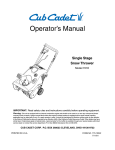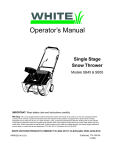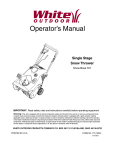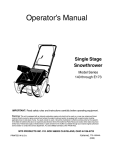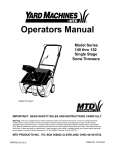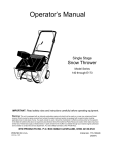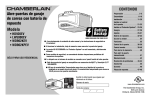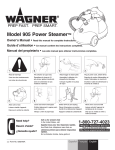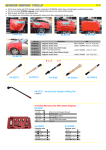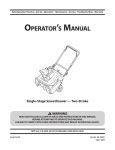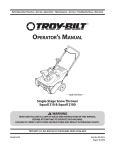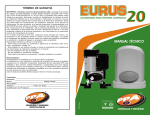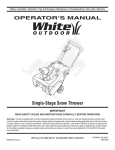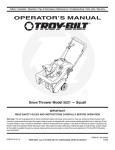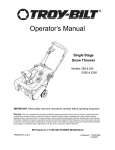Download MTD 285 Snow Blower User Manual
Transcript
Operator’s Manual Single Stage Snow Thrower Models 285 & 295 Models E285 &E295 IMPORTANT: Read safety rules and instructions carefully before operating equipment. Warning: This unit is equipped with an internal combustion engine and should not be used on or near any unimproved forestcovered, brush-covered or grass-covered land unless the engine’s exhaust system is equipped with a spark arrester meeting applicable local or state laws (if any). If a spark arrester is used, it should be maintained in effective working order by the operator. In the State of California the above is required by law (Section 4442 of the California Public Resources Code). Other states may have similar laws. Federal laws apply on federal lands. A spark arrester for the muffler is available through your nearest engine authorized service dealer or contact the service department, P.O. Box 368022 Cleveland, Ohio 44136-9722. MTD PRODUCTS INC. P.O. BOX 368022 CLEVELAND, OHIO 44136-9722 PRINTED IN U.S.A. FORM NO. 770-10540A 7/10/01 TABLE OF CONTENTS Content Page Important Safe Operation Practices .................................................................................. 3 Assembling Your Snow Thrower ....................................................................................... 5 Know Your Snow Thrower................................................................................................. 6 Operating Your Snow Thrower .......................................................................................... 7 Making Adjustments.......................................................................................................... 9 Maintaining Your Snow Thrower ....................................................................................... 10 Off-Season Storage .......................................................................................................... 11 Troubleshooting ................................................................................................................ 11 Parts List .......................................................................................................................... 12 FINDING MODEL NUMBER This Operator’s Manual is an important part of your new snow thrower. It will help you to assemble, prepare and maintain the unit for best performance. Please read and understand what it says. Before you start assembling your new snow thrower, please locate the model plate on the equipment and copy the information from it in the space provided below. The information on the model plate is very important if you need help from our Customer Support Department or an authorized dealer. • You can locate the model number by standing behind the unit in the operating position and looking down at the dash panel . A sample model plate is explained below. For future reference, please copy the model number and the serial number of the equipment in the space below. (Model Number) (Serial Number) Copy the model number here: Copy the serial number here: MTD PRODUCTS INC CLEVELAND, OHIO 44136 ENGINE INFORMATION The engine manufacturer is responsible for all engine-related issues with regards to performance, power-rating, specifications, warranty and service. Please refer to the engine manufacturer’s Owner’s/Operator’s Manual packed separately with your unit for more information. CALLING CUSTOMER SUPPORT If you have difficulty assembling this product or have any questions regarding the controls, operation or maintenance of this unit, please call the Customer Support Department. Call 1- (330) 220-4MTD (4683) or 1- (800)-800-7310 to reach a Customer Support representative. Please have your unit’s model number and serial number ready when you call. See previous section to locate this information. You will be asked to enter the serial number in order to process your call . For more details about your unit, visit our website at www.mtdproducts.com 2 SECTION 1: IMPORTANT SAFE OPERATION PRACTICES WARNING: This symbol points out important safety instructions which, if not followed, could endanger the personal safety and/or property of yourself and others. Read and follow all instructions in this manual before attempting to operate this machine. Failure to comply with these instructions may result in personal injury. When you see this symbol—heed its warning. WARNING: Engine Exhaust, some of its constituents, and certain vehicle components contain or emit chemicals known to State of California to cause cancer and birth defects or other reproductive harm. DANGER: This machine was built to be operated according to the rules for safe operation in this manual. As with any type of power equipment, carelessness or error on the part of the operator can result in serious injury. This machine is capable of amputating hands and feet and throwing objects. Failure to observe the following safety instructions could result in serious injury or death. Training 1. 2. 3. 4. 5. 6. 7. 6. 7. Read, understand, and follow all instructions on the machine and in the manual(s) before attempting to assemble and operate. Keep this manual in a safe place for future and regular reference and for ordering replacement parts. Be familiar with all controls and their proper operation. Know how to stop the machine and disengage them quickly. Never allow children under 14 years old to operate this machine. Children 14 years old and over should read and understand the operation instructions and safety rules in this manual and should be trained and supervised by a parent. Never allow adults to operate this machine without proper instruction. Thrown objects can cause serious personal injury. Plan your snow throwing pattern to avoid discharge of material toward roads, bystanders and the like. Keep bystanders, helpers, pets and children at least 75 feet from the machine while it is in operation. Stop machine if anyone enters the area. Exercise caution to avoid slipping or falling, especially when operating in reverse. 8. 9. Preparation 1. 2. 3. 4. 5. Thoroughly inspect the area where the equipment is to be used. Remove all door mats, newspapers, sleds, boards, wires and other objects which could be tripped over or thrown by the auger/impeller. Always wear safety glasses or eye shields during operation and while performing an adjustment or repair to protect your eyes. Thrown objects which ricochet can cause serious injury to the eyes. Do not operate without wearing adequate winter outer garments. Do not wear jewelry, long scarves or other loose clothing which could become entangled in moving parts. Wear footwear which will improve footing on slippery surfaces. Use a grounded three wire extension cord and receptacle for all units with electric start engines. Adjust collector housing height to clear gravel or crushed rock surfaces. Disengage all clutch levers before starting the engine. Never attempt to make any adjustments while engine is running, except where specifically recommended in the operator’s manual. Let engine and machine adjust to outdoor temperature before starting to clear snow. To avoid personal injury or property damage use extreme care in handling gasoline. Gasoline is extremely flammable and the vapors are explosive. Serious personal injury can occur when gasoline is spilled on yourself or your clothes which can ignite. Wash your skin and change clothes immediately. a. Use only an approved gasoline container. b. Extinguish all cigarettes, cigars, pipes and other sources of ignition. c. Never fuel machine indoors. d. Never remove gas cap or add fuel while the engine is hot or running. e. Allow engine to cool at least two minutes before refueling. f. Never over fill fuel tank. Fill tank to no more than ½ inch below bottom of filler neck to provide space for fuel expansion. g. Replace gasoline cap and tighten securely. h. If gasoline is spilled, wipe it off the engine and equipment. Move machine to another area. Wait 5 minutes before starting the engine. i. Never store the machine or fuel container inside where there is an open flame, spark or pilot light (e.g. furnace, water heater, space heater, clothes dryer etc.). j. Allow machine to cool at least 5 minutes before storing. Operation 1. 2. 3. 3 Do not put hands or feet near rotating parts, in the auger/ impeller housing or discharge chute. Contact with rotating parts can amputate hands and feet. The auger/impeller clutch lever is a safety device. Never bypass its operation. Doing so, makes the machine unsafe and may cause personal injury. The clutch levers must operate easily in both directions and automatically return to the disengaged position when released. 5. 6. 7. 8. 9. 10. 11. 12. 13. 14. 15. 16. 17. 18. 19. 20. Maintenance And Storage Never operate with a missing or damaged discharge chute. Keep all safety devices in place and working. Never run an engine indoors or in a poorly ventilated area. Engine exhaust contains carbon monoxide, an odorless and deadly gas. Do not operate machine while under the influence of alcohol or drugs. Muffler and engine become hot and can cause a burn. Do not touch. Exercise extreme caution when operating on or crossing gravel surfaces. Stay alert for hidden hazards or traffic. Exercise caution when changing direction and while operating on slopes. Plan your snow throwing pattern to avoid discharge towards windows, walls, cars etc. To avoid property damage or personal injury caused by a ricochet. Never direct discharge at children, bystanders and pets or allow anyone in front of the machine. Do not overload machine capacity by attempting to clear snow at too fast of a rate. Never operate this machine without good visibility or light. Always be sure of your footing and keep a firm hold on the handles. Walk, never run. Disengage power to the auger/impeller when transporting or not in use. Never operate machine at high transport speeds on slippery surfaces. Look down and behind and use care when in reverse. If the machine should start to vibrate abnormally, stop the engine, disconnect the spark plug and ground it against the engine. Inspect thoroughly for damage. Repair any damage before starting and operating. Disengage all clutch levers and stop engine before you leave the operating position (behind the handles). Wait until the auger/impeller comes to a complete stop before unclogging the discharge chute, making any adjustments, or inspections. Never put your hand in the discharge or collector openings. Always use a clearing tool to unclog the discharge opening. Use only attachments and accessories approved by the manufacturer (e.g. wheel weights, tire chains, cabs etc.). If situations occur which are not covered in this manual, use care and good judgment. Contact your dealer or telephone 1-800-800-7310 for assistance and the name of your nearest servicing dealer. 1. Never tamper with safety devices. Check their proper operation regularly. Disengage all clutch levers and stop engine. Wait until the auger/impeller come to a complete stop. Disconnect the spark plug wire and ground against the engine to prevent unintended starting before cleaning, repairing, or inspecting. 3. Check bolts, and screws for proper tightness at frequent intervals to keep the machine in safe working condition. Also, visually inspect machine for any damage. 4. Do not change the engine governor setting or over-speed the engine. The governor controls the maximum safe operating speed of the engine. 5. Snow thrower shave plates and skid shoes are subject to wear and damage. For your safety protection, frequently check all components and replace with original equipment manufacturer’s (O.E.M.) parts only. “Use of parts which do not meet the original equipment specifications may lead to improper performance and compromise safety!” 6. Check clutch controls periodically to verify they engage and disengage properly and adjust, if necessary. Refer to the adjustment section in this operator’s manual for instructions. 7. Maintain or replace safety and instruction labels, as necessary. 8. Observe proper disposal laws and regulations for gas, oil, etc. to protect the environment. 9. Prior to storing, run machine a few minutes to clear snow from machine and prevent freeze up of auger/impeller. 10. Never store the machine or fuel container inside where there is an open flame, spark or pilot light such as a water heater, furnace ,clothes dryer etc. 11. Always refer to the operator’s manual for proper instructions on off-season storage. 2. Your Responsibility: • Restrict the use of this power machine to persons who read, understand and follow the warnings and instructions in this manual and on the machine. AVOID INJURY FROM ROTATING AUGER KEEP HANDS, FEET AND CLOTHING AWAY. 4. DANGER 1. KEEP AWAY FROM ROTATING AUGER CONTACT WITH AUGER CAN AMPUTATE HANDS AND FEET. 2. DISENGAGE CLUTCH LEVERS, STOP ENGINE, AND REMAIN BEHIND HANDLES UNTIL ALL MOVING PARTS HAVE STOPPED BEFORE UNCLOGGING OR SERVICING MACHINE. 3. TO AVOID THROWN OBJECTS INJURIES, NEVER DIRECT DISCHARGE AT BYSTANDERS. USE EXTRA CAUTION WHEN OPERATING ON GRAVEL SURFACES. 4. READ OPERATOR'S MANUAL. NEVER PUT HAND IN CHUTE. CONTACT WITH ROTATING PARTS CAN AMPUTATE FINGERS AND HANDS. DO NOT UNCLOG DISCHARGE CHUTE WHILE ENGINE IS RUNNING. SHUT OFF ENGINE AND REMAIN BEHIND HANDLES UNTIL ALL MOVING PARTS HAVE STOPPED BEFORE UNCLOGGING. 4 SECTION 2: ASSEMBLING YOUR SNOW THROWER Unpacking From Carton • • • • Cut along corners of the carton and lay it down flat. Remove packing material. Remove any loose parts included with unit (i.e., operator’s manual, etc.). Roll unit out of carton. Check carton thoroughly for any remaining loose part. • • Remove the hairpin clip from the end of the lower chute crank. Insert the upper chute crank into the lower chute crank and align the holes. Re-insert the hairpin clip into the hole to secure the two chute cranks. See Figure 2. Items Required For Assembly 1. Pair of pliers 2. Engine oil 3. Fresh gasoline NOTE: All references to left or right side of the snow thrower is from the operating position only. Hairpin Clip Upper Chute Crank Before Assembly Lower Chute Crank WARNING: Disconnect the spark plug wire and ground it against the engine to prevent unintended starting. See Figure 1. NOTE: For clarity of viewing, the control handle is removed from the picture. Do not remove it for the task.. Raising Upper Handle • Loosen the hand knob on each side of the handle. Remove packing material, if any. Figure 2 Attaching Control Cable The control cable may already be attached to the control handle. If not attached, complete the following steps to attach it to the snow thrower housing. • Hand Knob Route the control cable over the lower handle. Insert the end of the cable into the hole in the control housing as shown in Figure 3. Push the plastic fitting until it locks into the control housing. Hand Knob Bottom Hole In Control Handle Spark Plug Access “Z” End of Cable Figure 1 • • Control Housing Raise the upper handle in the direction shown in Figure 1 until it clicks into the operating position. Make sure not to pinch or crimp the cable. Tighten the hand knobs. Plastic Fitting Figure 3 Attaching Chute Crank • The lower chute crank is already attached to your snow thrower at the factory. For shipping purposes, the upper chute crank is packaged as loose part. Attach it to the lower chute crank following instructions: 5 Lift the control handle up, and hook the “Z” end of the control cable into the bottom hole in the control handle, from the outside to the inside . If necessary, pull up on the end of the cable with a pair of pliers to obtain slack in order to hook it into the control handle. Hold the “Z” fitting with the pliers, not the cable, to avoid damaging the cable. Lower Chute Nut NOTE: The upper hole in the control handle provides for adjustment in belt tension. Refer to page 9 of this manual for instructions. Carriage Bolt Flat Washer Flat Washer Assembling Discharge Chute • • • Hex Bolt Turn the chute crank until the chute faces straight to the front. See Figure 4 . Remove the hand knob, flat washer and carriage bolt from the upper chute. See Figure 4. Pivot the upper chute up and over the lip of the lower chute. This will eliminate any gap between the upper and the lower chutes. Secure with hardware just removed. Upper Chute Hand Knob Figure 4 SECTION 3: KNOW YOUR SNOW THROWER WARNING: Be familiar with all the controls on the snow thrower and their proper operation. Know how to stop the machine and disengage them quickly. Auger Control Handle Recoil Starter Chute Crank Gasoline Cap Primer Key Electric Starter (if equipped) Spark Plug Access Discharge Chute Oil Fill Plug Auger Shave Plate Choke Lever Figure 5 Auger Control Handle Chute Crank Located on the upper handle, the auger control handle is used to engage and disengage the auger. The snow thrower is designed to propell by the rotation of the auger. Pull the control handle back against the upper handle to engage the auger; release to disengage. Located on right side of dash panel, the chute crank determines the direction that snow will be discharged. Turn clockwise to discharge snow to the left; turn counterclockwise to discharge to the right. 6 Discharge Chute Ignition Key The angle of the discharge chute controls the distance that the snow is thrown. Tilt the discharge chute up for greater distance; tilt down for less distance. Loosen the hand knob on the side of the discharge chute to adjust. Tilt the chute to the desired position, and tighten the knob. Used to start engine. Put key in “ON” position to start for both electric and recoil start engines. Follow starting instructions given in the next section. Recoil Starter Used to manually start the engine. Electric Starter (If equipped) Choke Lever Used to start engine with a 120V power source The location of the choke lever is indicated in Figure 5 inset. You will have to use this lever to start the engine. Push the lever all the way up to the FULL/ON position, or all the way down to the OFF position as desired. Plug for Electric Start (If equipped) Requires use of a three-prong outdoor extension cord and a 120V power source Primer Button Spark Plug Access Used to inject fuel directly into the carburetor to insure fast starts in cold weather. Follow engine manual to prime engine. Spark plug located under the access cover. SECTION 4: OPERATING YOUR SNOW THROWER Before Starting Press auger control handle to engage auger WARNING: Read, understand, and follow all instructions and warnings on the machine and in this manual before operating. • Turn handle to change discharge direction The spark plug wire was disconnected for safety. Attach spark plug wire to spark plug before starting. Gas and Oil Fill-Up • Primer Recoil Starter Key Check oil and gasoline level and add if necessary. Follow related instructions in the seperate engine manual packed with your snow thrower. Choke Lever WARNING: Use extreme care when handling gasoline. Gasoline is extremely flammable and the vapors are explosive. Never fuel the machine indoors or while the engine is hot or running. Extinguish cigarettes, cigars, pipes and other sources of ignition. Electric Starter* Spark Plug Access * If equipped Figure 6 To Start Engine • • • Insert ignition key into slot. Turn key to ON position. Now follow the instructions below as it pertains to your unit. • Electric Starter (If equipped) WARNING: The electric starter must be • used with a properly grounded three-prong receptacle at all times to avoid the possibility of electric shock. Follow all instructions carefully prior to operating the electric starter. • 7 The electric starter is equipped with a grounded three-wire power cord and plug, and is designed to operate on 120 volt AC household current. Determine that your house wiring is a three-wire grounded system. Ask a licensed electrician if you are not certain. If your home wiring system is not a three-wire grounded system, do not use this electric starter under any conditions. If your home electrical system is grounded, but a three-hole receptacle is not available, one should be installed by a licensed electrician before using the electric starter. • • • • • • If you have a grounded three-prong receptacle, proceed as follows. Rotate choke lever to FULL position. Connect power cord to switch box on dash panel. Plug the other end of power cord into a three-prong 120-volt, grounded, AC receptacle. Push starter button to crank engine. As you crank the engine, move choke lever to FULL choke position. When engine starts, release starter button, and move choke gradually to OFF. If engine falters, move choke immediately to FULL and then gradually to OFF. When disconnecting the power cord, always unplug from the three-prong receptacle first, and then from the snow thrower. • • Operating the Snow Thrower • Recoil Starter • • • • • Move choke lever to FULL choke position (cold engine start). If engine is warm, place choke in OFF position instead of FULL. Push primer button two or three times for cold engine start. If engine is warm, push primer button only once. • • NOTE: Always cover vent hole in primer button when pushing. Additional priming may be necessary for first start if temperature is below 15 degrees Fahrenheit. • • ter ea nce r G sta Di Grasp starter handle and pull rope out slowly, until it pulls slightly harder. Let rope rewind slowly. Pull starter handle rapidly. Do not allow handle to snap back. Allow it to rewind slowly while keeping a firm hold on the starter handle. As engine warms up and begins to operate evenly, rotate choke lever slowly to OFF position. If engine falters, return to FULL choke, then slowly move to OFF position. To stop engine, turn ignition key counter-clockwise. Disconnect the spark plug wire from the spark plug to prevent accidental starting while equipment is unattended. To help prevent possible freeze-up of starter, proceed as follows: • Hand Knob Operating Tips • • Upper Discharge Chute Figure 7 To Stop Engine • Adjust the upper discharge chute up or down as shown in Figure 4. You will have to loosen the hand knob to adjust the upper chute, and then retighten after correct adjustment is reached. Use the chute crank to position the discharge chute in order to discharge snow with the wind. After making sure no bystanders or obstacles are in front of the unit, engage the auger control handle. As the snow thrower starts to move, maintain a firm hold on the handle, and guide the snow thrower along the path to be cleared. Release the auger control handle to stop the snow throwing action and the forward motion. Di Les sta s nc e • or four times. Pulling the starter rope will produce a loud clattering sound, which is not harmful to the engine or starter. Wipe all snow and moisture from the carburetor cover in the area of the control levers. Also, move control levers back and forth several times. Leave throttle control lever in the STOP or OFF position. Leave choke control in the FULL choke position. Remove ignition key and disconnect spark plug wire to prevent accidental starting. • • Run engine for a few minutes before stopping to help dry off any moisture on the engine. Electric Starter: Connect power cord to switch box on engine, then to 120 volt AC receptacle. With the engine running, push starter button and spin the starter for several seconds. The unusual sound made by spinning the starter will not harm engine or starter. Disconnect the power cord from receptacle first, and then from switch box. Recoil Starter: With engine running, pull starter rope with a rapid, continuous full arm stroke three Discharge snow downwind whenever possible. Slightly overlap each previously cleared path. Lifting up on the handle will allow the rubber on the augers to propel the snow thrower forward. Pushing downward on the handle will raise the augers off the ground and stop forward motion. NOTE: Excessive upward pressure on the handle will result in premature wear on the rubber auger blades which would not be covered by warranty. • • Run the engine for a few minutes before stopping to help dry any moisture on the engine. Clean the snow thrower thoroughly after each use. WARNING: Muffler, engine and surrounding areas become hot and can cause a burn. Do not touch. 8 SECTION 5: MAKING ADJUSTMENTS Belt Tension WARNING: NEVER attempt to make any Periodic adjustment of the belt tension may be required due to normal stretch and wear on the belt. Adjust the belt tension, following instructions below, if the augers seem to hesitate while turning although engine maintains the same speed. adjustments while the engine is running, except where specified in the operator’s manual. Shave Plate • • To check the adjustment of the shave plate, place the unit on a level surface. See Figure 8. The wheels, shave plate and augers should all contact level surface. Note that if the shave plate is adjusted too high, snow may blow under the housing. If the shave plate wears out excessively, or the unit does not self-propel, the shave plate may be too low and needs to be adjusted. The upper hole in the control handle provides adjustment for belt tension. To adjust, disconnect the “Z” end of control cable from the bottom hole in the control handle. See Figure 10 . Hook the cable into the upper hole in control handle as shown. Upper Hole Clutch Cable NOTE: On new units or units with a new shave plate installed, the augers may be slightly off the ground. Control Housing Figure 10 If additional adjustment is required, follow steps below. • • Augers Shave Plate Figure 8 • Remove the belt cover by removing five hex screws that hold it in place. See Figure 12. There are three adjustment holes provided in the idler bracket assembly. See Figure 11. To adjust, move the extension spring on the end of the clutch cable to the next higher adjustment position on the idler bracket assembly. Reassemble belt cover. High Position To adjust, tip the snow thrower back so that it rests on the handle. Loosen the four lock nuts and bolts which secure the shave plate to the housing. See Figure 9. Move the shave plate to desired position and retighten the nuts and bolts securely. Idler Bracket Middle Position Low Position Auger Pulley Spring on End of Clutch Cable Figure 11 Carburetor WARNING: If any adjustments need to be made to the engine while the engine is running (e.g. carburetor), keep clear of all moving parts. Be careful of muffler, engine and other surrounding heated surfaces. • Lock Nut & Carriage Bolt Figure 9 9 Refer to the separate engine manual, packed with your unit, for carburetor adjustment information. SECTION 6: MAINTAINING YOUR SNOW THROWER Replacing Shave Plate WARNING: Before servicing, repairing, or The shave plate is attached to the bottom of the auger housing and is subject to wear. It should be checked periodically. There are two wearing edges and the shave plate can be reversed. See Figure 14. inspecting, disengage all clutch levers and stop engine. Wait until all moving parts have come to a complete stop. Disconnect spark plug wire and ground it against the engine to prevent unintended starting. • Replacing Belt • • • Remove the belt cover by removing five hex screws. See Figure 12. Remove the four carriage bolts and hex lock nuts which attach it to the snow thrower housing. Install new shave plate, making sure the heads of the carriage bolts are on the inside of the housing. Adjust the shave plate according to instructions on page 9. Tighten securely. Hex Screw Shave Plate Hex Screw Remove these hardware Belt Cover Figure 12 • • • • Figure 14 Pull up on the idler pulley and slip the belt off the engine pulley. Push down on the idler pulley and slip the belt off the auger pulley. Reassemble new belt. See Figure 13. Reinstall the belt cover. Engine • • Refer to the separate engine manual for all engine maintenance procedures. Check engine and snow thrower frequently for loose hardware, and tighten as needed. Lubrication • Idler Pulley • Engine Pulley Auger Pulley Drive Belt Figure 13 10 Lubricate pivot points on the control handle and the extension spring at the end of the clutch cable with a light oil once every season and before storage of the snow thrower at the end of the season. Lubricate the flange keepers on the chute crank once a season with a light oil making sure the crank rod moves freely. Remove bolts holding the shroud to the housing, and lift shroud to access the chute crank bracket. SECTION 7: OFF-SEASON STORAGE • • WARNING: Never store engine with fuel in tank indoors or in enclosed, poorly ventilated areas where fuel fumes may reach an open flame, spark or pilot light as on a furnace, water heater, clothes dryer, or other gas appliance. • • Follow “Storage” instructions in the Engine Manual. Store in a clean, dry area. Block the snow thrower up so it is not resting on the rubber auger blades. NOTE: When storing any type of power equipment in a poorly ventilated or metal storage shed, care should be taken to rustproof the equipment, especially springs, cables and all moving parts. Clean snow thrower thoroughly. Lubricate as instructed above with a light oil. SECTION 8: TROUBLESHOOTING GUIDE Problem Cause Remedy Engine fails to start 1. 2. 3. 4. 5. 6. 7. Fuel tank empty, or stale fuel Blocked fuel line Key not in ON position Spark plug wire disconnected Faulty spark plug Engine not primed Engine flooded with excessive priming 1. 2. 3. 4. 5. 6. 7. Fill tank with clean fresh gasoline. Clean fuel line Insert key and turn to ON position Connect wire to spark plug. Clean spark plug, readjust gap, or replace. Prime engine four times. Wait at least ten minutes before starting. Engine runs erratic 1. 2. Unit running on choke Fuel line blocked, or stale fuel 1. 2. 3. 4. Water or dirt in fuel system Carburetor out of adjustment 3. 4. Move choke lever to OFF position. Clean fuel line and fill tank with fresh, clean gasoline. Refer to engine manual for remedy. Refer to engine manual for remedy. Engine overheats 1. Carburetor out of adjustment 1. Refer to engine manual for instruction. Loss of power 1. 2. Spark plug wire loose Vent in gas cap plugged 1. 2. Connect and tighten spark plug wire. Clear vent. Excessive vibration 1. Loose parts or damaged auger 1. Stop engine immediately and disconnect spark plug wire. Check for possible damage. Tighten all bolts and nuts. Repair as needed. If the problem persists, take unit to an authorized service dealer. Drive cable out of adjustment 1. 2. Drive belt loose or damaged 2. Adjust drive cable following instructions on page 9 of this manual. Replace drive cable. 1. Discharge chute clogged 1. 2. Foreign object lodged in auger 2. 3. Drive cable not adjusted properly 3. 4. Drive belt loose or damaged 4. Unit fails to self-propel 1. Unit fails to discharge snow Stop engine immediately and disconnect spark plug wire. Clean discharge chute and the auger housing. Stop engine immediately and disconnect spark plug wire. Remove object . Adjust drive cable following instructions on page 9 of this manual. Replace drive belt. NOTE: For repairs beyond the minor adjustments listed above, contact your nearest authorized service representative or call 1-800-800-7310 for the Customer Support Center. Refer to the engine manual, packed with your snow thrower, for more engine related information. 11 SECTION 9: PARTS LIST FOR MODELS 285, 295, E285 AND E295 15 9 6 21 6 17 14 6 21 24 21 23 3 1 8 22 10 13 4 2 20 25 16 7 33 32 35 47 11 57 42 12 19 48 45 18 31 44 26 58 11 35 53 41 49 60 36 5 5 42 28 52 33 27 37 29 59 5 54 49 56 40 50 51 35 43 53 38 34 46 55 39 30 12 Models 285, 295, E285 and E295 Ref. No. 1. 2. 3. 4. 5. 6. 7. 8. 9. 10. 11. 12. 13. 14. 15. 16. 17. 18. 19. 20. 21. 22. 23. 24. 25. 26. 27. 28. 29. Part No. Part Description 747-1311 Upper Chute Crank Assemby 684-0177 Lower Chute Crank Assembly 684-0178 Bracket Assembly: Mitten Grip 731-2570 Shroud: Yellow, 7 Hp. Electric 731-2571 731-2607 710-0895 Shroud: Yellow, 5 Hp. Electric Shroud: Yellow, 5 Hp. Recoil TT Screw 1/4-15 x 0.75” 710-1003 B Screw #10-16 x 0.625” 710-1882 Hex Flange Screw 710-3083 Hex Bolt 5/16-18 x 1.375” 712-0252 Jam Nut 712-0429 Lock Nut 712-3010 Hex Nut 5/16-18 714-0104 Cotter Pin 714-0507 Cotter Pin 720-0201A Knob: Chute Crank 725-0201 Ignition Key 725-2018 Switch: Electric Start Key 726-0100 Push Cap 736-0119 Lock Washer 736-0185 Flat Washer 736-0225 Internal Lock Washer 736-0400 Flat Washer 736-0451 Saddle Washer 7519636 Mitten Grip Handle 684-0190 Spark Plug Access 749-0711A Upper Handle: Gull Wing 749-0796B Lower Handle 710-0167 Carriage Screw 1/4-20 x 0.50” 710-0191 Hex Bolt 710-0323 Machine Screw Ref. No. 30. 31. 32. 33. 34. 35. 36. 37. 38. 39. 40. 41. 42. 43. 44. 45. 46. 47. 48. 49. 50. 51. 52. 53. 54. 55. 56. 57. 58. 59. 60. 13 Part No. Part Description 710-0352 B Screw1/4-14 x 0.375” 710-0451 Carriage Bolt 710-0642 TT Screw 1/4-20 x 0.75” 710-0773 TT Screw 3/8-16 x 0.5” 710-0896 AB Screw 1/4-14 x 0.625” 710-1005 B Screw 1/4-14 x 0.5” 711-0848A Axle Tube 712-0116 Jam Lock Nut 712-3010 Hex Nut 5/16-18 712-3027 Lock Nut 731-1033 Shave Plate 732-0357A Extension Spring 736-0108 Flat Washer 736-0119 Lock Washer 736-0176 Flat Washer 736-0242 Beleville Washer 736-0326 Flat Washer 736-0329 Lock Washer 741-0475 Plastic Bushing 741-0600 Ball Bearing 746-0910A Clutch Cable 748-0234 Shoulder Spacer 756-0313 Flat Idler 784-5174 Bearing Cup 784-5175B Bracket: Brake Idler 784-5176 Belt Cover 784-5485 Auger Assembly 784-5720 Chute Crank Bracket 684-0196 Auger Housing Assembly 734-1799 Wheel Assembly 710-1090 Hex Flange Screw Models 285, 295, E285 and E295 19 16 24 18 1 15 7 5 11 10 15 8 17 Engine is for reference only and may not resemble the engine on your snow thrower. 9 6 13 25 3 Part of electric start engines 21 13 23 14 3 2 4 22 Ref. No. 1. 2. 3. 4. 5. 6. 7. 8. 9. 10. 11. 13. Part No. 629-0236 Description Extension Cord † 710-0157 Hex Bolt 5/16-24 x 0.75” 710-0409 Hex Bolt 5/16-24 x 1.75” 710-0502A TT Sems Screw 710-0751 Hex Screw 1/4-20 x 0.620” 710-1003 B Screw #10-16 x 0.625” † 710-3013 Hex Screw 1/4-20 x 0.50” 712-3006 Hex Nut 1/4-20 719-0581 Spacer 726-0205 Hose Clamp 731-2005 Choke Knob 736-0119 Lock Washer Ref. No. 14. 15. 16. 17. 18. 19. 20. 21. 22. 23. 24. 25. † For Electric Start models only ‡ For Model E295 only 14 20 Part No. 736-0242 Description Beleville Washer 736-0329 Lock Washer 741-0475 Plastic Bushing 751-0535 Fuel Line Hose 751-0540A Gas Tank 751-0603 Fuel Cap 754-0101A V-Belt 756-0416B V-Pulley Half 756-0475 Pulley 784-0322 Engine Mount 784-0323 Support Bracket 784-0374 Support Plate: Engine Mount ‡ Models 285, 295, E285 and E295 5 Ref. No. 9 8 10 3 2 4 Part No. Description 1. 710-0487 Carriage Screw 5/16-18 x 2.0” 2. 710-1270 Machine Screw 3. 712-0324 Hex Lock Nut 1/4-20 4. 720-0284 Hand Knob w/ Wing Nut 5. 720-0295 Foam Grip 6. 725-0157 Cable Tie 7. 736-0451 Saddle Washer 8. 746-0883 Control Housing 9. 747-0956 Auger Bail 749-0711A Upper Handle: Gull Wing 10. 1 6 7 7 4 5 Ref. No. 9 10 6 10 8 4 1 2 4 7 3 15 Part No. Description 1. 710-0276 2. 710-0451 Carr. Bolt 5/16-18 x 0.750” 3. 710-3015 Hex Screw 1/4-20 x 0.75” 4. 712-3027 Lock Nut 5. 712-3068 Hex Lock Nut 6. 720-0284 Hand Knob 7. 731-0851A Flange Keeper: Chute 8. 731-0915B Lower Chute 9. 731-0921 Upper Chute 10. 736-0159 Washer Carriage Screw: Special ÍNDICE Contenido Página Medidas importantes de seguridad ......................................................................................... 17 Montaje de su máquina quitanieve .......................................................................................... 19 Conozca la máquina quitanieve .............................................................................................. 20 Operación de su máquina quitanieve ...................................................................................... 21 Realización de ajustes ............................................................................................................ 23 Mantenimiento de su máquina quitanieve ............................................................................... 24 Almacenamiento fuera de temporada ..................................................................................... 25 Guía para la solución de problemas ........................................................................................ 25 BÚSQUEDA DEL NÚMERO DE MODELO Este manual de operador es una parte importante de su nueva máquina quitanieve. Le ayudará a montar, preparar y mantener la unidad para obtener los mejores resultados. Por favor lea y comprenda el contenido del manual. Antes de comenzar el montaje de la máquina quitanieve nueva, por favor encuentre la placa del modelo del equipo y copie la información contenida en la misma en el espacio provisto a continuación. La información contenida en la placa del modelo es muy importante en caso de necesitar ayuda de nuestro Departamento de Asistencia al Cliente o de un distribuidor autorizado. • Puede ubicar el número de modelo parándose detrás de la unidad en posición operativa y mirando hacia abajo en el tablero de instrumentos . A continuación se explica un ejemplo de placa de modelo. Para referencias futuras, por favor copie el número de modelo y el número de serie del equipo en el espacio a continuación. (Número de modelo) (Número de serie) Copie el número del modelo en este espacio: Copie el número de serie en este espacio: MTD PRODUCTS INC CLEVELAND, OHIO 44136 INFORMACIÓN ACERCA DEL MOTOR El fabricante del motor es el responsable de todas las cuestiones relacionadas con el rendimiento, potencia de salida, especificaciones, garantía y mantenimiento del motor. Por favor, para mayor confirmación, consulte el manual del dueño/ operador del fabricante del motor que es enviado, en un paquete por separado, junto con su unidad. SERVICIO TELEFÓNICO DE ASISTENCIA AL CLIENTE En caso de tener problemas para ensamblar este producto o de tener dudas con respecto a los controles, funcionamiento o mantenimiento del mismo, por favor comuníquese con el Departamento de asistencia al cliente. Llame al 1- (330) 220-4MTD (4683) o 1- (800)-800-7310 para comunicarse con un representante de asistencia al cliente. Por favor tenga a mano el número de modelo y el número de serie de su unidad cuando llame. Consulte la sección anterior para obtener esta información. Se le solicitará que ingrese el número de serie para poder procesar su llamada. Para obtener más detalles acerca de su unidad, visite nuestro sitio web en 16 ADVERTENCIA: Este símbolo indica importantes instrucciones de seguridad las cuales, en caso de no ser respetadas, podrían poner en peligro la seguridad del personal y/o sus bienes materiales y los de terceros. Lea y siga todas las instrucciones contenidas en este manual antes de intentar poner esta máquina en funcionamiento. De no hacerlo puede ocasionar lesiones. Cuando vea este símbolo—preste atención a la advertencia.. ADVERTENCIA: El escape del motor de este producto, algunos de sus componentes y algunos componentes del vehículo contienen o emiten productos químicos que el estado de California considera que pueden producir cáncer, defectos de nacimiento u otros problemas reproductivos. PELIGRO: Esta máquina está diseñada para ser utilizada respetando las reglas de seguridad contenidas en este manual. Al igual que con todos los equipos eléctricos si el operador es descuidado o comete errores puede ocasionar lesiones graves. Esta máquina puede amputar manos y pies y arrojar objetos. De no respetar las instrucciones de seguridad siguientes se pueden producir lesiones graves o la muerte. Capacitación 1. 2. 3. 4. 5. 6. 7. 8. Lea, comprenda y respete todas las instrucciones que figuran en la máquina o en este(os) manual(es) antes de proceder al montaje y operación del equipo. Guarde este manual en un lugar seguro para referencias futuras y regulares y para solicitar repuestos. Familiarícese con todos los controles y con el uso adecuado de los mismos. Sepa cómo detener la máquina y cómo desengranar los controles rápidamente. Nunca permita que niños menores de 14 años operen esta máquina. Los niños de 14 años y más deben leer y comprender las instrucciones de operación y las reglas de seguridad contenidas en este manual y deben ser capacitados y supervisados por uno de los padres. Nunca permita que adultos sin conocimientos acerca de la máquina operen la misma. Los objetos arrojados por la máquina pueden producir lesiones graves. Planifique el patrón en el que va a ir arrojando nieve para evitar que la descarga de material se realice hacia los caminos, los observadores, etc. Mantenga a los observadores, ayudantes, mascotas y a los niños por lo menos a 75 pies de la máquina mientras la misma está en funcionamiento. Detenga la máquina si alguien entra en la zona. Sea precavido para evitar patinarse o caerse especialmente cuando opera la máquina en reversa. 9. Preparativos 1. 2. 3. 4. 5. 6. 7. Revise minuciosamente la zona donde se utilizará el equipo. Quite todos los felpudos, periódicos, trineos, tablas, alambres y otros objetos que podrían engancharse o ser expulsados por la barrena/ motor. Para protegerse los ojos utilice siempre anteojos o antiparras de seguridad mientras opera la máquina o mientras la ajusta o repara. Los objetos arrojados que rebotan pueden lesionar gravemente la vista. No opere la máquina sin la vestimenta adecuada para estar al aire libre en invierno. No utilice alhajas, bufandas largas u otras prendas sueltas que podrían enredarse en las partes móviles. Utilice un calzado antideslizante para las superficies resbaladizas. Use un cordón prolongador y un tomacorriente de tres cables con conexión a tierra para todas las unidades con motores con encendido eléctrico. Ajuste la altura de la caja del tomacorriente para limpiar la grava o las superficies con piedras trituradas. Desengrane todas las palancas de embrague antes de arrancar el motor. Nunca intente realizar ajustes mientras el motor está en marcha excepto en los casos específicamente recomendados en el manual del operador. Deje que el motor y la máquina se adapten a la temperatura exterior antes de comenzar a sacar la nieve. Sea sumamente cuidadoso al manipular la gasolina para evitar lesiones o daños. La gasolina es altamente inflamable y los vapores son explosivos. Se puede lesionar gravemente si derrama gasolina sobre usted o sobre la ropa ya que se puede encender. Lave la piel y cámbiese de ropa de inmediato. a. Utilice sólo recipientes para gasolina aprobados. b. Apague todos los cigarrillos, cigarros, pipas y otras fuentes de combustión. c. Nunca cargue combustible en la máquina en un espacio cerrado. d. Nunca saque la tapa del gas ni agregue combustible mientras el motor está caliente o en marcha. e. Deje que el motor se enfríe por lo menos dos minutos antes de volver a cargar combustible. f. Nunca recargue el tanque de combustible. Llene el tanque no más de 1/2 pulgada por debajo de la base del cuello del filtro para dejar espacio para la dilatación del combustible. g. Vuelva a colocar la tapa de la gasolina y ajústela bien. h. Limpie la gasolina derramada sobre el motor y el equipo. Traslade la máquina a otra zona. Espere 5 minutos antes de encender el motor. i. Nunca almacene la máquina o el recipiente de combustible en un espacio cerrado donde haya fuego, chispas o luz piloto (por ejemplo, hornos, calentadores de agua, calefactores, secadores de ropa, etc.). j. Deje que la máquina se enfríe 5 minutos por lo menos antes de almacenarla. Funcionamiento 1. 2. 3. 4. 5. 17 No ponga las manos o los pies cerca de las piezas rotatorias, en la caja de la barrena / motor o en el canal de descarga. El contacto con piezas rotatorias puede amputar manos y pies. La palanca del embrague de la barrena / motor es un dispositivo de seguridad. Nunca pase por alto su funcionamiento. De hacerlo la operación de la máquina es riesgosa y puede ocasionar lesiones. Las palancas del embrague deben funcionar bien en ambas direcciones y regresar automáticamente a la posición de desengrane cuando se las suelta. Nunca opere la máquina si falta un canal de descarga o el mismo está dañado. Mantenga todos los dispositivos de seguridad en su lugar y en funcionamiento. Nunca encienda el motor en espacios cerrados o en una zona poco ventilada. El escape del motor contiene monóxido de carbono, un gas inodoro y letal. Espanól SECCIÓN 1: MEDIDAS IMPORTANTES DE SEGURIDAD 7. 8. 9. 10. 11. 12. 13. 14. 15. 16. 17. 18. 19. 20. Mantenimiento y almacenamiento No opere la máquina estando bajo los efectos del alcohol o de drogas. El silenciador y el motor se calientan y producen una quemadura. No los toque. Sea sumamente precavido cuando opere la máquina sobre una superficie con grava o cuando la cruce. Manténgase alerta por si se presentan peligros ocultos o tráfico. Tenga cuidado cuando cambie de dirección o cuando opere la máquina en pendientes. Planifique el patrón en el que va a ir arrojando nieve para evitar que la descarga de material se produzca hacia las ventanas, las paredes, los autos, etc. para evitar daños materiales o lesiones producidas por los rebotes. Nunca dirija la descarga hacia los niños, los observadores y a las mascotas ni deje que nadie se pare delante de la máquina. No sobrecargue la capacidad de la máquina tratando de sacar la nieve muy rápidamente. Nunca opere esta máquina si no tiene buena visibilidad o iluminación. Siempre debe estar seguro de que está bien afirmado y sostenga bien las manijas. Camine, nunca corra. Corte la corriente a la barrena / motor cuando transporte la máquina o cuando la misma no está en uso. Nunca opere la máquina a alta velocidad de desplazamiento sobre superficies resbaladizas. Mire hacia abajo y hacia atrás y tenga cuidado cuando la use en reversa. Si la máquina comenzara a vibrar de manera anormal, detenga el motor, desconecte la bujía y póngala de manera que haga masa contra el motor. Inspeccione la máquina minuciosamente para ver si está dañada. Repare todos los daños antes de encender y operar la máquina. Desengrane todas las palancas de embrague y detenga el motor antes de dejar la posición de operación (detrás de las manijas). Espere a que la barrena / motor se detenga por completo antes de destapar el canal de descarga, de realizar ajustes o inspecciones. Nunca ponga las manos en las aberturas de descarga o de recolección. Utilice siempre una herramienta de limpieza para destapar la abertura de descarga. Use sólo uniones y accesorios aprobados por el fabricante (por ejemplo, pesas para las ruedas, cadenas para los neumáticos, cabinas, etc.). Si se presentan situaciones que no están previstas en este manual sea cuidadoso y use el sentido común. Comuníquese con su distribuidor o llame al teléfono 1-800-800-7310 por ayuda y para obtener el nombre del distribuidor más cercano. 1. Nunca manipule los dispositivos de seguridad de manera imprudente. Verifique regularmente si funciona de manera correcta. 2. Desengrane todas las palancas de embrague y detenga el motor. Espere a que la barrena / motor se detenga por completo. Desconecte el cable de la bujía y póngalo de manera que haga masa contra el motor para evitar que se encienda de manera accidental antes de limpiar, reparar o revisar la máquina. 3. Controle frecuentemente que todos los pernos y tornillos estén bien ajustados para comprobar que la máquina se encuentra en condiciones seguras de operación. Además realice una inspección visual de la máquina para controlar si la misma está dañada. 4. No cambie la configuración del regulador del motor ni acelere demasiado el mismo. El regulador controla la velocidad máxima segura de operación del motor. 5. Las placas de raspado y los zapatos anti deslizantes de que se usan con la máquina quitanieves se desgastan y se dañan. Para proteger su seguridad, verifique frecuentemente todos los componentes y reemplácelos sólo con partes de los fabricantes de equipos originales (O.E.M.). “La utilización de partes que no cumplan con las especificaciones de equipos originales podría tener como resultado un rendimiento incorrecto y además la seguridad podría estar comprometida” 6. Revise los controles del embrague periódicamente para verificar que engranen y desengranen adecuadamente y ajústelos si es necesario. Consulte la sección de ajustes en este manual del operador para obtener instrucciones. 7. Mantenga o reemplace las etiquetas de seguridad e instrucciones según sea necesario. 8. Respete las leyes y reglamentaciones referentes a la disposición correcta de gas, aceite, etc. para proteger el medio ambiente. 9. Antes de almacenar la máquina enciéndala unos minutos para sacar la nieve que haya quedado en la misma y para evitar así que se congele la barrena / motor. 10. Nunca almacene la máquina o el recipiente de combustible en un espacio cerrado donde haya fuego, chispas o luz piloto como por ejemplo, calentadores de agua, hornos, secadores de ropa, etc. 11. Siempre consulte el manual del operador para obtener instrucciones correctas acerca del almacenamiento fuera de temporada. Su responsabilidad: • Sólo permita que usen esta máquina eléctrica las personas que lean, comprendan y respeten las advertencias y las instrucciones que aparecen en este manual y en la máquina. AVOID INJURY FROM ROTATING AUGER KEEP HANDS, FEET AND CLOTHING AWAY. 6. DANGER 1. KEEP AWAY FROM ROTATING AUGER CONTACT WITH AUGER CAN AMPUTATE HANDS AND FEET. 2. DISENGAGE CLUTCH LEVERS, STOP ENGINE, AND REMAIN BEHIND HANDLES UNTIL ALL MOVING PARTS HAVE STOPPED BEFORE UNCLOGGING OR SERVICING MACHINE. 3. TO AVOID THROWN OBJECTS INJURIES, NEVER DIRECT DISCHARGE AT BYSTANDERS. USE EXTRA CAUTION WHEN OPERATING ON GRAVEL SURFACES. 4. READ OPERATOR'S MANUAL. NEVER PUT HAND IN CHUTE. CONTACT WITH ROTATING PARTS CAN AMPUTATE FINGERS AND HANDS. DO NOT UNCLOG DISCHARGE CHUTE WHILE ENGINE IS RUNNING. SHUT OFF ENGINE AND REMAIN BEHIND HANDLES UNTIL ALL MOVING PARTS HAVE STOPPED BEFORE UNCLOGGING. 18 SECCIÓN 2: MONTAJE DE LA MÁQUINA QUITANIEVE Desempaque de la caja de cartón • • • • Corte las esquinas de la caja de cartón y extiéndala en el piso. Quite el material de empaque. Quite cualquier parte suelta que se incluya con su unidad (por ejemplo, el manual del operador, etc.). Deslice la unidad hasta sacarla de la caja de cartón. Verifique cuidadosamente si en la caja queda alguna parte suelta. Reinserte la broche de horquilla en el agujero para asegurar las dos manivelas del canal. Ver Figura 2. Piezas necesarias para el montaje 1. 2. 3. Par de pinzas Aceite del motor Gasolina fresca Broche de horquilla NOTA: Las referencias a los lados derecho o izquierdo de la máquina quitanieve se hacen observando la misma desde la posición de operación. Canal inferior Manivela Antes del montaje ADVERTENCIA: Desconecte el cable de la bujía y póngalo de manera que haga masa contra el motor para evitar que se encienda de manera accidental. Ver Figura 1. ACLARACIÓN: Para una de la imagen, mejor claridad la manija de control no aparece en el dibujo. No la quite para operar el equipo. Figura 2 Elevación del mango superior • Canal superior Manivela Instalación del cable de control Afloje la perilla manual de cada lado del mango. Quite el material de empaque, en caso de existir. Es posible que el cable de control ya esté unido a la manija de control. Si no está unido, complete los siguientes pasos para unirlo a la caja de la máquina quitanieve. • Pase el cable de control por encima de la manija inferior. Inserte el extremo del cable en el agujero de la caja de control tal como se exhibe Figura 3. Ubique el accesorio plástico hasta que encaje en la caja de control. Perilla manual Fondo Agujero Control Manija Extremo “Z” del cable Perilla manual Control Caja Bujía de encendid Acceso Plástico Accesorio Figura 1 • • Figura 3 Eleve el mango superior en la dirección que se exhibe Figura 1 hasta que encaje en la posición operativa. Asegúrese de no apretar o rebordear el cable. Ajuste las perillas manuales. • Ajuste la manivela del canal La manivela del canal inferior ya fue instalada en fábrica en su máquina quitanieve. Por razones de envío, la manivela del canal superior está empaquetada como una parte separada. Adósela a la manivela del canal inferior siguiendo las siguientes instrucciones: • Quite el broche de horquilla de la manivela del canal inferior. • Inserte la manivela del canal superior en la manivela del canal inferior y alinee los agujeros. Eleve la palanca de control y enganche el extremo “Z” del cable de control en el agujero del fondo de la manija de control, desde el exterior y el interior . En caso de ser necesario, tire hacia arriba el extremo del cable con un par de pinzas para aflojarlo y poder engancharlo en la manija de control. Mantenga el accesorio “Z” con las pinzas, no el cable, para evitar dañar al cable. NOTA: El agujero superior en la manija de control permite ajustar la tensión de la banda. Consulte la página 23 de este manual por las instrucciones. 19 Montaje del canal de descarga • • • Canal inferior Gire la manivela del canal hasta que el canal esté ubicado hacia el frente. Vea Figura 4 . Quite la perilla manual, la arandela plana y el perno del carro del canal superior. Ver Figura 4. Gire el canal superior por encima del borde del canal inferior. Esto eliminará cualquier espacio entre los canales superiores e inferiores. Asegúrelo con las piezas metálicas que acaba de quitar. Tuerca Carro Perno Plana Arandela Plana Arandela Bulón hexagonal Superior Canal Manual Perilla Figura 4 SECCIÓN 3: CONOZCA LA MÁQUINA QUITANIEVE ADVERTENCIA: Familiarícese con el uso de todos los controles de la máquina quitanieve y con su correcto funcionamiento. Sepa cómo detener la máquina y cómo desengranar los controles rápidamente. Manija de control de la barrena Arrancador de retroceso Manivela del canal Tapa de la gasolina Cebador Llave Arrancador eléctrico (si es parte del equipo) Acceso a la bujía Canal de descarga Tapón para llenado de aceite Barrena Placa de raspado Palanca de obturación Figura 5 Manija de control de la barrena Manivela del canal Ubicada en la manija superior, la manija de control de la barrena se utiliza para enganchar y desenganchar la barrena. La máquina quitanieve está diseñada para avanzar por rotación de la barrena. Empuje la manija de control contra la manija superior para enganchar la barrena, suelte para desengancharla. Ubicada en el lado derecho del tablero de instrumentos, la manivela del canal determina la dirección en que se descargará la nieve. Gire en sentido de las agujas del reloj para descargar la nieve hacia la izquierda; gire en dirección contraria de las agujas del reloj para descargarla hacia la derecha. 20 Canal de descarga Llave de encendido El ángulo del canal de descarga controla la distancia a la cual se arroja la nieve. Incline el canal de descarga hacia arriba si quiere que la nieve sea arrojada a una distancia mayor; incline hacia abajo si quiere que la descarga se realice a menor distancia. Afloje la perilla manual del lado del canal de descarga para ajustarlo. Incline el canal hacia la posición deseada y ajuste a perilla. Se utiliza para encender el motor. Coloque la llave en posición “ON” para iniciar tanto el motor eléctrico como los motores arrancadores de retroceso. Siga las instrucciones de inicio que se brindan en la siguiente sección. Arrancador de retroceso Se utiliza para encender manualmente el motor. Arrancador eléctrico (si es parte del equipo) Palanca de obturación Utilizado para encender el motor con una fuente de potencia de 120V La ubicación de la palanca de obturación está indicada en la sección de inserción de la Figura 5. Deberá utilizar esta palanca para arrancar el motor. Empuje la palanca completamente hacia arriba a la posición FULL/ON, o completamente hacia abajo a la posición OFF, según se desee. Enchufe para inicio eléctrico(si es parte del equipo) Exige el uso de un cable de extensión de tres terminales para exteriores y una fuente de alimentación de 120V Botón del cebador Acceso a la bujía Se utiliza para inyectar combustible directamente en el carburador para asegurar que el motor se inicie rápidamente en climas fríos. Siga las instrucciones el manual del motor para cebarlo. La bujía está ubicada debajo de la cubierta de acceso. SECCIÓN 4: FUNCIONAMIENTO DE LA MÁQUINA QUITANIEVE Antes de encender tierra y está diseñado para operar con corriente doméstica de 120 voltios ADVERTENCIA: Lea, comprenda y siga todas las instrucciones y advertencias que aparecen en la máquina y en este manual antes de operarla. • Manija de control Barrena de presión la barrena para enganchar El cable de la bujía fue desconectado por seguridad. Enchufe el cable de la bujía a la bujía antes de encender la máquina. Gire la manija para cambiar descarga dirección Llenado de gasolina y aceite • Verifique el nivel de aceite y gasolina y agregue en caso de ser necesario. Siga las instrucciones correspondientes que se indican en el manual del motor que se incluye por separado con su máquina quitanieve. Eléctrico Arrancador* Obturación Palanca Acceso a la bujía * Si es parte Para encender el motor Inserte la llave de encendido en la ranura. Gire la llave a la • posición ON (encendido). Ahora siga las instrucciones que aparecen debajo según corresponda a su unidad. Figura 6 • Arrancador eléctrico (si es parte del equipo) • ADVERTENCIA: El arrancador eléctrico debe • ser utilizado con un receptáculo de tres terminales correctamente conectado a tierra en todo momento para evitar la posibilidad de descargas eléctricas. Siga todas las instrucciones cuidadosamente para operar el arrancador eléctrico. • Retroceso Arrancador Llave ADVERTENCIA: Tenga extremo cuidado cuando manipule la gasolina. La gasolina es altamente inflamable y los vapores son explosivos. Nunca le agregue combustible a la máquina en interiores o mientras el motor está caliente o en funcionamiento. Apague todos los cigarrillos, cigarros, pipas y otras fuentes de combustión. • Cebador • El arrancador eléctrico está equipado con un cable de alimentación y un enchufe de tres terminales conectados a • 21 Determine si el cableado de su hogar es un sistema de tres cables conectado a tierra. Consulte con un electricista matriculado si no está seguro. Si su sistema de cableado doméstico no es un sistema de tres terminales con conexión a tierra, no utilice este motor eléctrico bajo ningún tipo de condiciones. Si su sistema de cableado doméstico es un sistema con conexión a tierra, pero no cuenta con un receptáculo de tres terminales, debe indicarle a un electricista con experiencia que lo instale antes de utilizar el arrancador eléctrico. Si cuenta con un receptáculo de tres terminales, siga los siguientes pasos. Rote la palanca de obturación a posición FULL (total). • • • • Conecte el cable de alimentación a la caja del interruptor en el tablero de instrumentos. Enchufe el otro extremo del cable de alimentación en un receptáculo de CA con conexión a tierra de tres terminales de 120 voltios. Presione el botón del arrancador para arrancar el motor con la manivela. A medida que intenta encender el motor con la manivela, mueva la palanca de obturación hacia la posición de obturación FULL. Cuando se inicia el motor, suelte el botón del arrancador, y mueva el obturador gradualmente a la posición OFF (apagado). Si el motor falla, mueva el obturador inmediatamente a posición FULL y luego gradualmente a OFF. Cuando desconecte el cable de alimentación, siempre desenchúfelo en primer lugar del receptáculo de tres terminales, y luego de la máquina quitanieve. • • Funcionamiento de la máquina quitanieve • Arrancador de retroceso • • • • Rote la palanca de obturación a posición de obturación FULL (encendido con el motor en frío). Si el motor está caliente, ubique el obturador en posición OFF en lugar de FULL. Presione el botón del cebador dos o tres veces para iniciar el motor en frío. Si el motor está caliente, presione el botón del cebador una sola vez. • • NOTA: Siempre cubra el agujero de ventilación en el botón cebador cuando lo presiona. Tal vez sea necesario un cebado adicional para iniciar el equipo por primera vez si la temperatura es menor a 15 grados Fahrenheit. • • • Tome con firmeza la manija del arrancador y tire de la soga lentamente hasta que quede un poco más tirante. Deje que la soga se enrosque lentamente. Tire de la manija del arrancador rápidamente. No permita que la manija se desenganche. Permita que se enrosque lentamente mientras mantiene firmemente la manija del arrancador. Mientras el motor se calienta y comienza a funcionar de manera pareja, rote la palanca del obturador lentamente hacia la posición OFF. Si el motor falla, gire hacia el obturador FULL, luego mueva lentamente hacia posición OFF. Ajuste el canal de descarga superior hacia arriba o hacia abajo tal como se muestra en Figura 4. Tendrá que soltar la perilla manual para ajustar el canal superior y luego volver a ajustarla una vez que se ha logrado el ajuste correcto. Utilice la manivela del canal para ubicar el canal de descarga de manera que descargue la nieve en dirección al viento. Después de asegurarse de que no haya ningún transeúnte ni ningún objeto enfrente de la unidad, enganche la manija de control de la barrena. A medida que la máquina quitanieve comienza a moverse, sostenga firmemente la manija y guíe la máquina a lo largo del camino que desea limpiar. Suelte la manija de control de la barrena para que la máquina deje de arrojar nieve y de desplazarse hacia adelante. r yo ncia a M s ta Di D i Me st no an r ci a • de manera continua y seguida. Al tirar de la soga del arrancador se oirá un fuerte sonido de traqueteo, el cual no daña al motor ni al arrancador. Limpie toda la nieve y la humedad de la tapa del carburador en el área de las palancas de control. Además, mueva las palancas de control hacia delante y hacia atrás varias veces. Deje la palanca de control de la mariposa en posición STOP (detención) o en posición OFF. Deje el control de obturación en la posición de obturación FULL. Quite la llave de encendido y desconecte el cable de la bujía para evitar que la máquina pueda encenderse accidentalmente. Superior Descarga Canal Manual Perilla Figura 7 Para detener el motor • Para detener el motor, gire la llave de encendido en dirección de las agujas del reloj. Desconecte el cable de la bujía de la bujía para evitar que se encienda accidentalmente mientras no se está prestando atención al equipo. Para ayudar a prevenir un posible congelamiento del arrancador, proceda de la siguiente manera: • Deje encendido el motor durante algunos minutos antes de detenerlo para permitir que se seque la humedad en el mismo. • Arrancador eléctrico: Conecte el cable de alimentación a la caja del interruptor del motor y luego al receptáculo de CA de 120 voltios. Con el motor funcionando, presione el botón del arrancador y deje girar el arrancador por varios segundos. El sonido inusual que realiza el arrancador al girar no dañará al motor ni al arrancador. Desconecte el cable de alimentación del receptáculo primero y de la caja del interruptor luego. • Arrancador de retroceso: Con el motor en funcionamiento, tire con fuerza de la soga del arrancador tres o cuatro veces Consejos de operación • • En lo posible, descargue la nieve en dirección al viento. Recubra ligeramente cada trayecto previamente despejado. Si eleva la manija, la goma de la barrena impulsará la máquina quitanieve hacia adelante. Si presiona la manija hacia abajo, elevará la barrena del piso y detendrá el avance la máquina. NOTA: Una excesiva presión ascendente sobre la manija tendrá como resultado un desgaste prematuro de las cuchillas de goma de la barrena y esto no estará cubierto por la garantía. • • Deje el motor encendido durante algunos minutos antes de detenerlo para ayudar a secar toda presencia de humedad en el motor. Limpie cuidadosamente la máquina quitanieve después de cada uso. ADVERTENCIA: El silenciador, el motor y las areas circundantes se recalientan y pueden causar quemaduras. No los toque. 22 SECCIÓN 5: REALIZACIÓN DE AJUSTES Tensión de la banda ADVERTENCIA: NUNCA intente realizar Es posible que se requieran ajustes periódicos de la tensión de la banda debido al estiramiento y al desgaste normal de la banda. Ajuste la tensión de la banda, siguiendo las instrucciones que aparecen debajo si las barrenas parecen temblar cuando giran a pesar de que el motor mantiene la misma velocidad,. algún tipo de ajuste mientras el motor está encendido, excepto los ajustes especificados en el manual del operador. Placa de raspado • • Para verificar el ajuste de la placa de raspado, ubique la unidad sobre una superficie nivelada. Vea Figura 8. Tanto las ruedas como la placa de raspado y las barrenas deben hacer contacto con la superficie nivelada. Fíjese que si la placa de raspado está demasiado alta la nieve puede volar debajo de la caja. Si la placa de raspado se desgasta excesivamente, o la unidad no se autopropulsa, es posible que la placa de raspado esté demasiado baja y deba ser ajustada. El agujero superior en la manija de control permite ajustar la tensión de la banda. Para ajustarla, desconecte el extremo “Z” del cable de control desde el agujero ubicado en el fondo de la manija de control. Vea Figura 10 . Enganche el cable en el agujero superior de la manija de control tal como se exhibe. Superior Agujero NOTA: En las unidades nuevas o en las que tienen una placa Embrague Cable de raspado nueva las barrenas pueden estar un poco separadas del suelo. Control Caja Figura 10 Barrenas Si se requiere un ajuste adicional, siga los siguientes pasos: • Quite la cubierta de la banda extrayendo los cinco tornillos hexagonales que la sostienen. Ver Figura 12. • Hay tres agujeros de ajuste en el montaje del soporte intermedio. Vea Figura 11. Para ajustar, mueva el resorte de extensión ubicado en el extremo del cable del embrague a la siguiente posición de ajuste en el montaje del soporte intermedio. Vuelva a montar la cubierta de la banda. Placa de raspado Posición alta Figura 8 • Intermedio Soporte Para ajustarlas incline la máquina quitanieve hacia atrás de manera que quede apoyada sobre la manija. Afloje las cuatro tuercas y pernos de seguridad que fijan la placa de raspado a la caja. Ver Figura 9. Mueva la placa de raspado hacia la posición deseada y vuelva a ajustar las tuercas y los pernos de manera segura. Posición media Posición baja Barrena Accionamiento Polea Extremo del embrague Cable Figura 11 Carburador ADVERTENCIA: Si es necesario realizar algún ajuste al motor (por ejemplo al carburador), quite todas las partes móviles. Tenga cuidado con el silenciador, el motor y otras superficies recalentadas alrededor del mismo. • Tuerca de seguridad & perno del carro Figura 9 23 Remítase al manual del motor, que está empacado con su unidad por separado para obtener información acerca del carburador. SECCIÓN 6: MANTENIMIENTO DE LA MÁQUINA QUITANIEVE Reemplace la placa de raspado ADVERTENCIA: Antes de realizar tareas de La placa de raspado está adosada al fondo de la barrena y puede desgastarse. Debe ser controlada de manera periódica. Hay dos bordes de desgaste ya que la placa de raspado puede ser invertida. Ver Figura 14. • Quite los cuatro pernos del carro y las tuercas de seguridad hexagonales que se adosan a la caja de la máquina quitanieve. • Instale una nueva placa de raspado, asegurándose de que las tapas de los pernos del carro se encuentren en el lado interior de la caja. • Ajuste la placa de raspado de acuerdo a las instrucciones que aparecen en la página 23. Ajústelos bien. mantenimiento, reparación o inspección, desenganche todas las palancas del embrague y detenga el motor. Espere a que se detengan todas las piezas que se mueven. Desconecte la bujía y póngala de manera que haga masa contra el motor. Reemplace las bandas • Quite la cubierta de la banda extrayendo los cinco tornilloshexagonales. Ver Figura 12. Hexagonal Tornillo de raspa Placa Tornillo hexagonal Cubierta de la banda Figura 12 • • • • Quite estas piezas metálicas Figura 14 Tire hacia arriba la polea loca y deslice la banda hasta sacarla de la polea del motor. Tire hacia abajo la polea loca y deslice la banda hasta sacarla de la polea de la barrena. Vuelva a montar la banda nueva. Ver Figura 13. Reinstale la cubierta de la banda. Motor • • Remítase al manual del motor para obtener información acerca de todos los procedimientos de mantenimiento del motor. Verifique con frecuencia el motor y la máquina quitanieve para controlar que no haya piezas metálicas sueltas; en caso de haber alguna suelta ajústela. Lubricación • Polea loca • Motor Polea Barrena Polea Transmisión Banda Figura 13 24 Lubrique los puntos de giro de la manija de control y del resorte de extensión del extremo del cable del embrague con un aceite liviano una vez por temporada y antes de almacenar la máquina quitanieve al final de la temporada. Lubrique los fijadores de la brida en la manivela del canal una vez por temporada con un aceite liviano asegurándose de que la varilla de la manivela se mueva libremente. Quite los pernos que sujetan el refuerzo a la caja, y eleve el refuerzo para acceder al soporte de la manivela del canal. SECCIÓN 7: ALMACENAMIENTO FUERA DE TEMPORADA • ADVERTENCIA: Nunca almacene el motor con combustible en el tanque en un espacio cerrado y con poca ventilación donde los gases del combustible puedan alcanzar el fuego, chispas o una luz piloto como la que tienen algunos hornos, calentadores de agua, calefactores, secadores de ropa o algún otro dispositivo a gas. • • • Siga las instrucciones de la sección de “Storage” (almacenamiento) del manual del motor. Almacénela en un área despejada y seca. Trabe la máquina quitanieve de manera que no se apoye sobre las cuchillas de goma de la barrena. NOTA: Cuando almacene cualquier tipo de equipo eléctrico en un galpón de depósito metálico o con poca ventilación, tenga especial cuidado de realizarle un tratamiento anti- oxidante al equipo, especialmente a los resortes, los cables y todas las partes móviles. Limpie minuciosamente la máquina quitanieve. Lubríquela tal como se indica en las instrucciones anteriores con un aceite liviano. SECCIÓN 8: GUÍA PARA LA SOLUCIÓN DE PROBLEMAS Problema El motor no arranca Causa 1. 2. 3. 4. 5. 6. 7. Solución El tanque de combustible está vacío o el combustible es viejo La línea del combustible está bloqueada La llave no está en posición ON Se ha desconectado el cable de la bujía La bujía no funciona correctamente El motor no se ceba El motor está ahogado ya que ha sido cebado en exceso 1. 2. 3. 4. 5. 6. 7. El motor funciona de manera errática 1. 2. La unidad está funcionando en la posición obturación La línea del combustible está tapada o el mismo es viejo 3. 4. Agua o suciedad en el sistema del combustible Es necesario ajustar el carburador 1. 2. 3. 4. Llene el tanque con gasolina limpia. Limpie la línea del combustible Inserte la llave y póngala en la posición ON (encendido) Conecte el cable a la bujía. Limpie la bujía, ajuste la distancia disruptiva o cambie la bujía. Cebe el motor cuatro veces. Aguarde al menos diez minutos antes de encender el motor. Cambie la palanca de obturación a la posición OFF (apagado). Limpie la línea del combustible y llene el tanque con gasolina limpia y fresca. Remítase al manual del motor para solucionar el problema. Remítase al manual del motor para solucionar el problema. El motor recalienta 1. Es necesario ajustar el carburador 1. Remítase al manual del motor para obtener instrucciones. Pérdida de potencia 1. 2. El cable de la bujía está flojo La ventilación de la tapa de gasolina está obstruida 1. 2. Conecte y ajuste el cable de la bujía. Destape la ventilación. Demasiada vibración 1. Hay piezas que están flojas o la barrena está dañada 1. Detenga el motor de inmediato y desconecte el cable de la bujía. Controle si la máquina está dañada. Ajuste todos los bulones y las tuercas. Realice las reparaciones necesarias. Si el problema continúa, lleve la unidad a un distribuidor autorizado. La unidad no se autopropulsa 1. El cable de transmisión está flojo 1. 2. Banda de transmisión suelta o dañada Ajuste el cable de transmisión siguiendo las instrucciones que aparecen en la página 9 de este manual. Reemplace el cable de transmisión. La unidad no descarga la 1. nieve 2. El canal de descarga está tapado 1. 2. Hay un objeto extraño en la barrena 2. 3. El cable de transmisión no está ajustado correctamente 3. 4. La banda de transmisión está floja o dañada 4. Detenga el motor de inmediato y desconecte el cable de la bujía. Limpie el canal de descarga y la caja de la barrena. Detenga el motor de inmediato y desconecte el cable de la bujía. Saque el objeto. Ajuste el cable de transmisión siguiendo las instrucciones en la página 9 de este manual. Reemplace la banda de transmisión. NOTA: Para realizar otras reparaciones que no sean los ajustes menores que se enumeran arriba, comuníquese con el representante del servicio autorizado más cercano o llame al 1-800-800-7310 para comunicarse con el centro de asistencia al cliente. Remítase al manual del motor, que se incluye con su máquina quitanieve, para obtener mayor información relacionada con el motor. 25 Your Notes/Vuestro Apuntes 26 Your Notes/Vuestro Apuntes 27 MANUFACTURER’S LIMITED WARRANTY FOR: The limited warranty set forth below is given by MTD PRODUCTS INC (“MTD”) with respect to new merchandise purchased and used in the United States, its possessions and territories. MTD warrants this product against defects in material and workmanship for a period of two (2) years commencing on the date of original purchase and will, at its option, repair or replace, free of charge, any part found to be defective in material or workmanship. This limited warranty shall only apply if this product has been operated and maintained in accordance with the Operator’s Manual furnished with the product, and has not been subject to misuse, abuse, commercial use, neglect, accident, improper maintenance, alteration, vandalism, theft, fire, water or damage because of other peril or natural disaster. Damage resulting from the installation or use of any accessory or attachment not approved by MTD Products Inc. for use with the product(s) covered by this manual will void your warranty as to any resulting damages. Normal wear parts or components thereof are subject to separate terms as follows: All normal wear part or component failures will be covered on the product for a period of 90 days regardless of cause. After 90 days, but within the two year period, normal wear part failures will be covered ONLY IF caused by defects in material or workmanship of OTHER component parts. Normal wear parts and components include, but are not limited to, belts, blades, blade adapters, grass bags, rider deck wheels, seats, snow thrower skid shoes, shave plates and tires. Batteries are covered by a 90-day limited replacement warranty. HOW TO OBTAIN SERVICE: Warranty service is available, WITH PROOF OF PURCHASE THROUGH YOUR LOCAL AUTHORIZED SERVICE DEALER. To locate the dealer in your area, please check for a listing in the Yellow Pages or contact the Customer Service Department of MTD PRODUCTS INC by calling 1-800-800-7310 or writing to P.O. Box 368022, Cleveland, Ohio 44136-9722. No product returned directly to the factory will be accepted unless prior written permission has been extended by the Customer Service Department of MTD PRODUCTS INC. This limited warranty does not provide coverage in the following cases: a. The engine or component parts thereof. These items carry a separate manufacturer’s warranty. Please refer to the applicable manufacturer’s warranty on these items. b. Routine maintenance items such as lubricants, filters, blade sharpening and tune-ups, or adjustments such as brake adjustments, clutch adjustments or deck adjustments; and normal deterioration of the exterior finish due to use or exposure. c. Log splitter pumps, valves and cylinders have a separate one year warranty. d. MTD does not extend any warranty for products sold or exported outside of the United States of America, its possessions and territories, except those sold through MTD authorized channels of export distribution. No implied warranty, including any implied warranty of merchantability or fitness for a particular purpose, applies after the applicable period of express written warranty above as to the parts as identified. No other express warranty or guaranty, whether written or oral, except as mentioned above, given by any person or entity, including a dealer or retailer, with respect to any product shall bind MTD. During the period of the Warranty, the exclusive remedy is repair or replacement of the product as set forth above. (Some states do not allow limitations on how long an implied warranty lasts, so the above limitation may not apply to you.) The provisions as set forth in this Warranty provide the sole and exclusive remedy arising from the sales. MTD shall not be liable for incidental or consequential loss or damages including, without limitation, expenses incurred for substitute or replacement lawn care services, for transportation or for related expenses, or for rental expenses to temporarily replace a warranted product. (Some states do not allow the exclusion or limitation of incidental or consequential damages, so the above exclusion or limitation may not apply to you.) In no event shall recovery of any kind be greater than the amount of the purchase price of the product sold. Alteration of the safety features of the product shall void this Warranty. You assume the risk and liability for loss, damage, or injury to you and your property and/or to others and their property arising out of the use or misuse or inability to use the product. This limited warranty shall not extend to anyone other than the original purchaser, original lessee or the person for whom it was purchased as a gift. How State Law Relates to this Warranty: This limited warranty gives you specific legal rights, and you may also have other rights which vary from state to state.




























